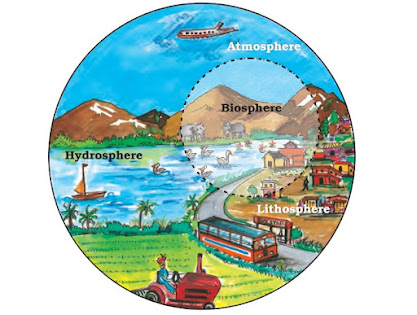Air
Our earth is surrounded by a huge blanket of air called atmosphere. All living beings on this earth depend on the atmosphere for their survival. It provides us the air we breathe and protects us from the harmful effects of the sun’s rays. Without this blanket of protection, we would be baked alive by the heat of the sun during day and get frozen during night. So it is this mass of air that has made the temperature on the earth livable.
COMPOSITION OF THE ATMOSPHERE
Nitrogen and oxygen
are two gases which make up the bulk of the
atmosphere. Carbon
dioxide, helium,
ozone, argon and
hydrogen are found
in lesser quantities.
Apart from these
gases, tiny dust
particles are also
present in the air.
Nitrogen is the most
plentiful gas in the air. When
we inhale, we take some
amount of nitrogen into our
lungs and exhale it. But
plants need nitrogen for their
survival. They can not take nitrogen directly from the air. Bacteria, that live in the
soil and roots of some plants, take nitrogen from the
air and change its form so that plants can use it.
Oxygen is the second most plentiful gas in the air.
Humans and animals take oxygen from the air as they
breathe. Green plants produce oxygen during
photosynthesis. In this way oxygen content in the air
remains constant. If we cut trees then this balance
gets disturbed.
Carbon dioxide is another important gas. Green
plants use carbon dioxide to make their food and
release oxygen. Humans or animals release carbon
dioxide. The amount of carbon dioxide released by
humans or animals seems to be equal to the amount
used by the plants which make a perfect balance.
However, the balance is upset by burning of fuels, such
as coal and oil. They add billions of tons of carbon
dioxide into the atmosphere each year. As a result, the
increased volume of carbon dioxide is affecting the
earth’s weather and climate.
STRUCTURE OF THE ATMOSPHERE
Our atmosphere is divided into five layers starting from
the earth’s surface. These are Troposphere,
Stratosphere, Mesosphere, Thermosphere and
Exosphere .
- Troposphere: This layer is the most important layer of the atmosphere. Its average height is 13 km. The air we breathe exists here. Almost all the weather phenomena like rainfall, fog and hailstorm occur in this layer.
- Stratosphere: Above the troposphere lies the stratosphere. It extends up to a height of 50 km. This layer is almost free from clouds and associated weather phenomenon, making conditions most ideal for flying airplanes. One important feature of stratosphere is that it contains a layer of ozone gas.
- Mesosphere: This is the third layer of the atmosphere. It lies above the stratosphere. It extends up to the height of 80 km. Meteorites burn up in this layer on entering from the space.
- Thermosphere: In thermosphere temperature rises very rapidly with increasing height. Ionosphere is a part of this layer. It extends between 80-400 km. This layer helps in radio transmission. In fact, radio waves transmitted from the earth are reflected back to the earth by this layer.
- Exosphere: The upper most layer of the atmosphere is known as exosphere. This layer has very thin air. Light gases like helium and hydrogen float into the space from here.




Comments
Post a Comment